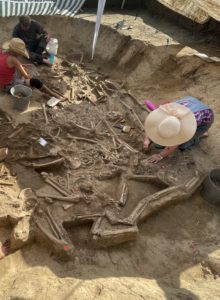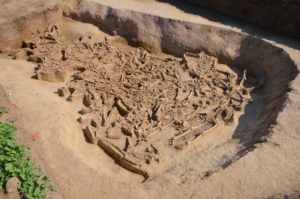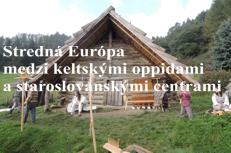
The international research team of archaeologists composed of the experts from the Institute of Archaeology (SAS) and the Christian Albrecht’s Universität zu Kiel has researched one of the biggest Central-European settlement agglomerations dated to the Neolithic. The team has been excavating the site for 7 seasons. The settlement existed between 5250–4950 B. C. The three discovered settlements spread over the area of around 50 ha. One of them was fortified with one, maybe even two ditches in the last phase of settlement. This situation is very rare in Central Europe during the Neolithic. Geophysical research has revealed more than 300 long houses. The archaeologists estimate that 50-70 houses were used contemporarily in individual chronological phases.
Already in the past seasons, regular graves around and in the ditch were discovered, but the archaeologists also unearthed skeletons thrown in the bottom of the ditch. This year, an accumulation of human bones was uncovered in the trench near one of the entrances, from which at least 35 skeletons were recovered. The bodies lay in different positions – on the back, on the stomach, on the side, some were found in the stretched “frog position.” All individuals were without head, only one child skull and one mandible were discovered. Peri-mortem fractures were recorded on some of the bones.

Only few accompanying findings were found at the bodies. An interesting found is represented by drilled human teeth, which could have been a component part of some amulets. So far it seems that there were many adolescents and young individuals buried in the trench.
Now, the international interdisciplinary team is about to perform a set of additional analyses which will help us to solve issues such as whether the individuals were intentionally killed, if they were victims of an epidemic event, represent the remains of cult ceremonies, whether they had some mutual genetic links to each other, if their heads were severed intentionally (cut off, chopped off) or post-mortem. Consequently, we will be able to solve other questions regarding social classification and emerging social differentiation in the conditions of early agricultural societies. And maybe we will be able to reconstruct the way the Neolithic society worked and reveal the reason of the fall of this extensive agglomeration.

Authors of text: Ivan Cheben, Zuzana Hukeľová, Matej Ruttkay (Archeologický ústav SAV, v. v. i.), Martin Furholt, Maria Wunderlich (Christian-Albrechts-Universität Kiel)
Head of archaeological research representing the Institute of Archeology (SAS), Nitra: PhDr. Ivan Cheben, CSc.
Head of archaeological research representing the Institute of Pre- and Protohistoric Archaeology, Christian Albrecht’s Universität zu Kiel: Prof. Dr. Martin Furholt.
The research is carried out in the framework of projects DFG (CRC 1266), APVV a VEGA and with support of the Institute of Archeology (SAS)



